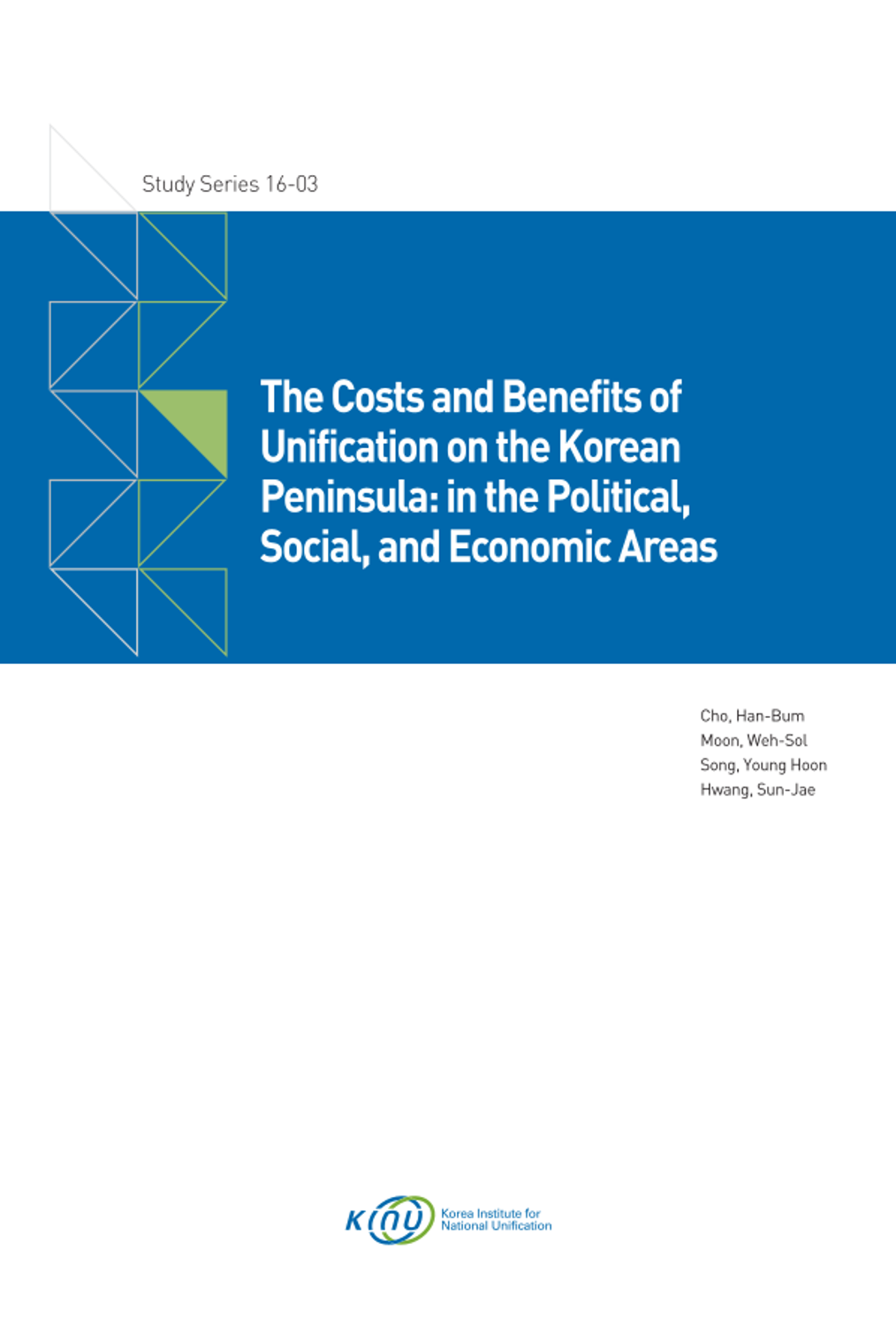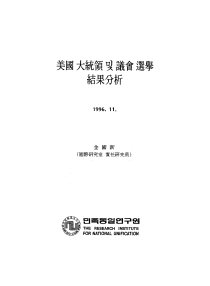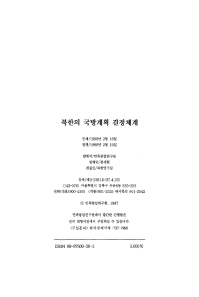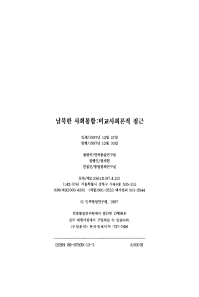
연구원발간물Study Series 2016-03
The Costs and Benefits of Unification on the Korean Peninsula: in the Political, Social, and Economic Areas
- 발행사항
- Seoul : Korea Institute for National Unification, 2016
- 형태사항
- 52p. ; 23cm
- 총서사항
- Study Series
- ISBN
- 9788984798427
- 청구기호
- 000 SS16-03
소장정보
| 위치 | 등록번호 | 청구기호 / 출력 | 상태 | 반납예정일 |
|---|---|---|---|---|
이용 가능 (2) | ||||
| 1자료실 | G0016112 | 대출가능 | - | |
| 1자료실 | G0016113 | 대출가능 | - | |
이용 가능 (2)
- 등록번호
- G0016112
- 상태/반납예정일
- 대출가능
- -
- 위치/청구기호(출력)
- 1자료실
- 등록번호
- G0016113
- 상태/반납예정일
- 대출가능
- -
- 위치/청구기호(출력)
- 1자료실
책 소개
At the New Year’s press conference in January 2014, President Park Geun-hye coined the term “unification bonanza” and launched the Presidential Committee for Unification Preparation (PCUP) as a follow-up measure to Dresden Initiative. The notion of unification bonanza and a series of steps taken afterward have significant implications since those measures are not just about partial policy adjustments but are a reflection of the paradigm shift from policy toward North Korea to unification. The previous governments’ policy on North Korea and unification attempted to modify inter-Korean relations with the reflection of the circumstantial changes, namely the deconstruction of the Cold War regime, and eventually, is evaluated to have made progress in inter-Korean relations in various aspects.
Based on the directionality of inter-Korean reconciliation and cooperation, the Kim Dae-jung administration’s engagement policy toward North Korea sought feasible means to improve inter-Korean relations. Such attempts could be assessed as having made the turning point to transform inter-Korean relations dominated by the Cold War-type paradigm.1) The Roh Moo-hyun administration’s peace and prosperity policy, also grounded on engagement policy, has the identical directionality with the previous administration’s policy at its core. Its policy on North Korea had the realistic goal of building a foundation for peaceful unification and focused on preparing the means to realize such goal. The direction taken by the Lee Myung-bak administration differed from that of ‘the Participatory Government’ as the power shifted to the conservative side. Resolving the issues raised in the North Korea policy implementation process of the past was set as the major policy objective since the directionality of the policy toward the North of the Lee administration was somewhat different from that of the previous governments. Especially, the Lee administration set inducing North Korea to change its attitude as the major policy direction toward North Korea based on ROK-U.S. alliance. Accordingly, the inauguration of the Lee administration signaled a switch of the policy direction to some degree based on the critical assessment of the policy on North Korea for 10 years since the Kim Dae-jung administration. However, despite the shift of the Cold War paradigm, the undismantled Cold War framework and the culture defined by the notion of the Cold War on the Korean Peninsula resulted in an increasing fatigue over the North Korean issue and became a barrier to improving inter-Korean relations.
From the Kim Dae-jung administration to the Lee Myung-bak administration, Seoul’s policy principles on North Korea and unification had its roots grounded on the paradigm of the policy toward North Korea. That is attributable to the fact that the stable management and improvement of inter-Korean relations and preparations for building the foundations of unification were set as the main policy objective rather than the achievement of unification. Unification was set as a long-term goal, which had led to act as constraints in formulating an active discourse on unification to some degree. The incumbent Park Geun-hye administration distinguishes itself from the previous ones by setting the unification as the direct objective, which is confirmed by its suggestion of “unification bonanza” and the launch of PCUP.
As the policy orientation has shifted to unification paradigm, the establishment of a practical foundation for unification has been set as the main goal of the Trust-building Process on the Korean Peninsula along with the improvement of inter-Korean relations and settlement of peace on the Korean Peninsula. Under the Park administration, unification has been set as the policy goal moving beyond a mere slogan. And the need for actual preparations for unification has become the administration’s major policy task. Hence, there have been improved interests in unification among the public. And various venues for discussions have been created to forge unification discourse under Park’s presidency.
In spite of the shift to the unification policy paradigm, it is difficult to state that the perceptions on unification have been radically upgraded within the South Korean society. The development of the South Korean society, its incorporation into the capitalist system, and the advancement of globalization have resulted in the weakening of the nationalistic particularity, including unification and North Korea issues and the advent of stronger behavioral norms of universality. The weakening unification discourse is hardly a temporary phenomenon, which is attributable to the structural change in the environment. What gets in the way of improving the perception toward the North is this structural background that has a negative influence on forming the positive unification discourse along with the South-South conflicts and the fixated framework of the unification issues as a politicized debate.
Above all, the concern over the uncertainty of unification in the future becomes a barrier in raising awareness of unification. The South Korean society has already witnessed the limits of the compressive growth model and faces various issues, such as weakening growth engine, increasing youth unemployment, and vulnerable welfare system as it has entered an aging society with the low economic growth. Such circumstances act as a breeding ground for expanding the concern over the uncertainty of future unification. Especially, the issue of unification costs, as observed in German unification, is also seen as a negative factor that acts as a hinderance to raising the awareness on Korean unification.
Therefore, presenting the optimistic vision on the future unification and promoting a clear understanding of the unification costs and benefits are necessary in increasing the awareness of unification. The division on the Korean Peninsula is problematic in a sense that it incurs the astronomical costs coupled with imposing various opportunity costs. The division on the Korean Peninsula has negatively affected the South Korea’s development in a sense that it has fundamentally hindered the transportation and logistics system of export-dependent Korean economy. The division has made both Koreas to annually spend the astronomical costs out of their budget on defense and 2 million North Korean youth are bound to compulsorily serve in the military from two to ten years. On the other hand, unified Korea will give a birth to a vast single market of 75 million people and the Korean Peninsula could function as a hub in the global transportation and logistics system that links the integrating Eurasian economic bloc and the Pacific. Unification not only can bring us the economic benefits but also give us the opportunity for new changes in politics and society. The current divided state has served as a hindrance in the political and social realms in the South Korean society. Acute military confrontations on the Korean Peninsula, including the North's nuclear threat have made people of both Koreas carry the fear for war with them all the time and served as a main reason for the so-called Korean discount the notion that international investors undervalue the Korean stocks to some extent due to the existing possibility of war. In particular, the structure of incurring a high cost in the Korean society has been formulated due to the structure of the severe social conflict in the South, including a South-South discord, the confrontational political culture, and ideological rigidity. To this end, it is worthy to note that the subdual of division system eventuates in the completion of one Korean state, together with a myriad of economic, political, and social benefits.
The comprehensive research on unification costs and benefits emphasizes that having a clear and objective recognition on unification is the starting point for unification preparation. This paper describes the research findings from the final year of the comprehensive research on unification costs and benefits that began in 2011. The research was initiated with the aim to: 1) objectively and accurately analyze the efforts and benefits for realizing the unification - the national task - 2)and to make the actual preparations for it. The study has been continuously carried out as a five-year project to overcome the limitation of the past that the numerous studies on unification costs and benefits has lacked systemic and comprehensive elements without promoting any continuity or integration with other researches.
For the systematic analysis, the study categorizes the unification costs and benefits by each area, applies a category to each stage of unification, analyzes the areas, in which the unification costs and benefits will be created, and divides them into domestic and international realms. The study attempts to systematically classify the unification cost as a unification task and the unification benefit as a unification effect by categorizing the areas, subject to unification costs and benefits, into three parts - politics, society, and economy. This research seeks to overcome the limits of existing fragmented studies on unification costs and benefits through a temporal and spatial approach to unification costs and benefits depending on the three stages of unification - stage of resolving the division, stage of integrating the system, and the completion stage of building the nation...
목차
1. Introduction
2. Area of Politics
3. Area of Society
4. Area of Economics : Macroeconomic Effects of Unification
5. Conclusion






